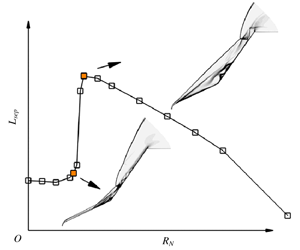Crossref Citations
This article has been cited by the following publications. This list is generated based on data provided by
Crossref.
Hao, Jiaao
Cao, Shibin
Wen, Chih-Yung
and
Olivier, Herbert
2021.
Occurrence of global instability in hypersonic compression corner flow.
Journal of Fluid Mechanics,
Vol. 919,
Issue. ,
Cao, Shibin
Hao, Jiaao
Klioutchnikov, Igor
Olivier, Herbert
Heufer, Karl Alexander
and
Wen, Chih-Yung
2021.
Leading-edge bluntness effects on hypersonic three-dimensional flows over a compression ramp.
Journal of Fluid Mechanics,
Vol. 923,
Issue. ,
Hong, Qizhen
Hao, Jiaao
Uy, Ken Chun Kit
Wen, Chih-Yung
and
Sun, Quanhua
2022.
Thermochemical nonequilibrium effects on high-enthalpy double-wedge flows.
Physics of Fluids,
Vol. 34,
Issue. 6,
Chen, Zongnan
Hao, Jiaao
and
Wen, Chih-Yung
2022.
Control of supersonic compression corner flow using a plasma actuator.
Physics of Fluids,
Vol. 34,
Issue. 7,
Hao, Jiaao
Fan, Jianhui
Cao, Shibin
and
Wen, Chih-Yung
2022.
Three-dimensionality of hypersonic laminar flow over a double cone.
Journal of Fluid Mechanics,
Vol. 935,
Issue. ,
Dai, Chunliang
Sun, Bo
Zhuo, Changfei
Zhou, Shengbing
Zhou, Changsheng
and
Yue, Lianjie
2022.
Numerical study of high temperature non-equilibrium effects of double-wedge in hypervelocity flow.
Aerospace Science and Technology,
Vol. 124,
Issue. ,
p.
107526.
Dai, Chunliang
Sun, Bo
Zhou, Shengbing
Zhuo, Changfei
Zhou, Changsheng
and
Yue, Lianjie
2022.
Influence of high temperature non-equilibrium effects on Mach 12 scramjet inlet.
Acta Astronautica,
Vol. 193,
Issue. ,
p.
237.
Fan, Jianhui
Hao, Jiaao
and
Wen, Chih-Yung
2022.
Nonlinear interactions of global instabilities in hypersonic laminar flow over a double cone.
Physics of Fluids,
Vol. 34,
Issue. 12,
Song, Ziming
and
Hao, Jiaao
2023.
Global instability of the interaction between an oblique shock and a laminar boundary layer.
Physics of Fluids,
Vol. 35,
Issue. 8,
Adityanarayan Ray, Anurag
and
De, Ashoke
2023.
Leading-edge bluntness effects on the hypersonic flow over the double wedge at multiple aft-wedge angles.
Physics of Fluids,
Vol. 35,
Issue. 5,
Dai, Chunliang
Sun, Bo
Zhao, Dan
Zhou, Shengbing
Zhou, Changsheng
and
Man, Yanjin
2023.
High temperature non-equilibrium flow characteristics of impinging shock/flat-plate turbulent boundary layer interaction at Mach 8.42.
Physics of Fluids,
Vol. 35,
Issue. 9,
Li, Cheng
and
Hao, Jiaao
2023.
Global stability of supersonic flow over a hollow cylinder/flare.
Journal of Fluid Mechanics,
Vol. 975,
Issue. ,
Hao, Jiaao
Cao, Shibin
Guo, Peixu
and
Wen, Chih-Yung
2023.
Response of hypersonic compression corner flow to upstream disturbances.
Journal of Fluid Mechanics,
Vol. 964,
Issue. ,
Uy, Ken Chun Kit
Hao, Jiaao
Zhao, Rui
and
Wen, Chih-Yung
2023.
Stabilization of hypersonic boundary-layer instability using porous coatings under thermochemical nonequilibrium.
Aerospace Science and Technology,
Vol. 141,
Issue. ,
p.
108520.
Guo, Peixu
Hao, Jiaao
and
Wen, Chih-Yung
2023.
Interaction and breakdown induced by multiple optimal disturbances in hypersonic boundary layer.
Journal of Fluid Mechanics,
Vol. 974,
Issue. ,
Hao, Jiaao
2023.
On the low-frequency unsteadiness in shock wave–turbulent boundary layer interactions.
Journal of Fluid Mechanics,
Vol. 971,
Issue. ,
2023.
Transitional criterion and hysteresis of multiple shock–shock interference.
Physics of Fluids,
Vol. 35,
Issue. 4,
Pal, Ribhu
and
Roy, Arnab
2024.
Shock turbulent interaction during shock-wave/boundary layer interaction over double wedge.
Physics of Fluids,
Vol. 36,
Issue. 10,
Dai, Chunliang
Sun, Bo
Man, Yanjin
and
Zhou, Changsheng
2024.
Effects of high-temperature and entropy layer of Mach 12 oblique shock wave.
Journal of Physics: Conference Series,
Vol. 2746,
Issue. 1,
p.
012006.
Yu, Kaikai
Hao, Jiaao
Wen, Chih-Yung
and
Xu, Jinglei
2024.
Bi-global stability of supersonic backward-facing step flow.
Journal of Fluid Mechanics,
Vol. 981,
Issue. ,

 $25{-}55^{\circ }$ double-cone configuration is numerically investigated. A moderate-enthalpy flow of
$25{-}55^{\circ }$ double-cone configuration is numerically investigated. A moderate-enthalpy flow of  $5~\text{MJ}~\text{kg}^{-1}$ with a Mach number of 9.87 and a unit Reynolds number of
$5~\text{MJ}~\text{kg}^{-1}$ with a Mach number of 9.87 and a unit Reynolds number of  $1.5\times 10^{5}~\text{m}^{-1}$ is considered. Special emphasis is given to the influence of leading-edge bluntness. The results indicate that the double-cone flow is insensitive to small bluntness in terms of shock structures, separation region sizes and surface pressure and heat flux distributions. A critical nose radius is observed, beyond which the separation bubble grows dramatically. The numerical data are analysed and interpreted based on a triple-deck formulation. It is shown that the sudden change in flow features is mainly caused by pressure overexpansion on the first cone due to leading-edge bluntness, such that the skin friction upstream of the separation is significantly reduced and the upstream pressure can no longer resist the large adverse pressure gradient induced by shock impingement. An estimation of the critical radius is established based on the pressure correlations of Blick & Francis (AIAA J., vol. 4 (3), 1966, pp. 547–549) for spherically blunted cones. Simulations at a higher enthalpy with the presence of both vibrational relaxation and air chemistry show a similar trend with increasing nose radius. The proposed criterion agrees well with the experimental observations.
$1.5\times 10^{5}~\text{m}^{-1}$ is considered. Special emphasis is given to the influence of leading-edge bluntness. The results indicate that the double-cone flow is insensitive to small bluntness in terms of shock structures, separation region sizes and surface pressure and heat flux distributions. A critical nose radius is observed, beyond which the separation bubble grows dramatically. The numerical data are analysed and interpreted based on a triple-deck formulation. It is shown that the sudden change in flow features is mainly caused by pressure overexpansion on the first cone due to leading-edge bluntness, such that the skin friction upstream of the separation is significantly reduced and the upstream pressure can no longer resist the large adverse pressure gradient induced by shock impingement. An estimation of the critical radius is established based on the pressure correlations of Blick & Francis (AIAA J., vol. 4 (3), 1966, pp. 547–549) for spherically blunted cones. Simulations at a higher enthalpy with the presence of both vibrational relaxation and air chemistry show a similar trend with increasing nose radius. The proposed criterion agrees well with the experimental observations.
